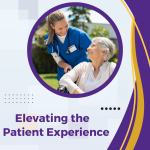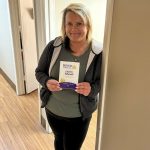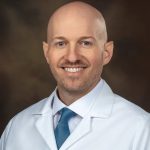Dealing with declining lungs: Weapons to control COPD
Bobbi Brown, a respiratory therapist with Lakeland Regional Health, discusses how lung patients can use an exercise band.
ROBIN WILLIAMS ADAMS / LEDGER CORRESPONDENT
Published: Thursday, March 3, 2016
Chronic obstructive pulmonary diseases like emphysema and non-reversible asthma pull patients into a downward spiral of constantly worsening health unless they fight back.
The weapons available to help them control COPD include exercise, education, learning better breathing methods, taking medications as prescribed and going on oxygen if necessary.
Patients employing those techniques usually can short circuit the decline or slow it down considerably, along with improving their quality of life, say patients and health professionals familiar with the lung-damaging diseases.
Quitting smoking, which accounts for 8 of 10 COPDrelated deaths, is a given. Patients who are overweight can benefit from shedding a few pounds. Lowering overly high blood pressure also helps.
Leora Clark quit smoking after being diagnosed with emphysema 25 years ago, but an ugly surprise was in store for her.
“They didn’t tell me my lungs would progressively get worse,” the Lakeland woman said.
Her wake-up call to take more aggressive action came about five years ago when she was hospitalized for pneumonia and told she had severe COPD. Her lungs were functioning at about 32 percent of their capacity.
“I was in the hospital for a week and they would not let me go home without oxygen,” said Clark, who is 62.
Determined not to spend the rest of her life tethered to a tank, she eagerly accepted her doctor’s advice to get pulmonary rehabilitation at South Florida Baptist Hospital in Plant City and took a free yoga class for COPD patients at the doctor’s Brandon office.
Clark said she now walks 5 or 6 miles daily at Lakeland Square Mall and swims a couple of times a week. She no longer needs oxygen.
COPD is an umbrella term for progressive lung diseases such as chronic bronchitis, refractory (non-reversible) asthma, emphysema and some forms of bronchiectasis, according to the COPD Foundation. Bronchiectasis is a chronic condition in which the walls of the airways, bronchi, are thickened from inflammation and infection.
Shortness of breath and morning coughing are early symptoms.
Auburndale resident Connie Shockley was diagnosed with a lung infection and COPD after a heart attack, her second, in 2009. Her doctor didn’t prescribe oxygen and Shockley, 59, didn’t want her condition to get bad enough that she would need it.
She found the Mary Sand Clinic at the Florida Department of Health’s Auburndale clinic. The free clinic, supported by donations, gives some COPD patients an opportunity to exercise under the supervision of nurses.
“This has helped me,” Shockley said, praising the support she gets there. “I do feel better overall, but you have good days and bad days.”
She walks on a treadmill for about 30 minutes and tries for 10 minutes to 15 minutes on a bicycle, although bicycling is harder for her.
“Most everyone who comes here is a lot worse than I am,” Shockley said. “It’s so beneficial for them. It gives a lot of them incentive to get out of bed.”
Adjusting without giving up
Dr. Jesse Romeu-Velez, pulmonary specialist at Bond Clinic in Winter Haven, encourages COPD patients to go to Mary Sand or to a “phase three” outpatient pulmonary program at Winter Haven Hospital for patients who already have gotten pulmonary rehabilitation.
Doing unsupervised exercise also is possible.
“You can do it in your home,” Romeu-Velez said. “This is not a hundred-meter run.”
He tells patients to do simple exercises, such as lifting 2-pound to 3-pound weights while watching television, in addition to walking. That can build up their upper chests and expand lung capacity.
Chronic lung diseases get progressively worse without movement and some form of exercise.
“I tell them to walk, walk, walk,” said Jennifer Dickinson, clinical nursing supervisor of the Health Department’s Auburndale unit. “You don’t have to run a marathon, but exercise is so important to their overall well-being.”
Along with its physical benefits, walking can help combat the depression some COPD patients experience.
“Depression is an issue for people with COPD,” said Monica Guy, a licensed practical nurse who supervises at Mary Sand Clinic. “I’ve seen so many people here help each other deal with this change in their lives.”
They supply their patients with information about their conditions and ways to cope.
Education is the key at Huffers and Puffers, a pulmonary support group at Lakeland Regional Health. It’s a chapter of the Better Breathers clubs through the American Lung Association. Any lung patient can attend, said Bobbi Brown, an LRH respiratory therapist who manages the local group.
“Part of the education is about communication, communicating their needs and educating them so they know what to ask about,” Brown said. “I try to give them tools to better manage themselves and their physician visits.”
She finds patients often don’t fully understand their lung disease, how it relates to other health problems and sometimes don’t know how to clean their breathing equipment properly. Soap and water alone aren’t enough. Disinfecting also is needed to kill bacteria that can form there.
Education, communication improve success
People with COPD need to make sure their physicians know which other doctors they see and all of the drugs they’re being prescribed, Brown said, adding, “I’ve had patients on the same drug with different names that different doctors prescribe.”
With the advent of stronger drugs for managing chronic obstructive pulmonary disease and devices that combine different drugs, doctors must make extra efforts to ensure patients don’t take some of them too often.
“We have newer medications, which came out about three years ago, that are longer acting, that you only need to take once a day,” Romeu-Velez said.
He educates patients on the difference between those more-powerful drugs and the lesspowerful, shorter-acting “rescue” inhalers or dilators used when people’s symptoms flare up.
Brown encounters patients who are prescribed oxygen and then don’t take it, increasing their risk of developing heart problems.
“A lot of people with lung diseases can have congestive heart failure,” Brown added.
She teaches COPD patients techniques such as breathing from the diaphragm instead of from the chest and “pursed lips” breathing that keeps airways open longer and lets the person release more stale air.
Being able to get more air without exerting as much energy relieves one of COPD patients’ biggest fears.
“As they get short of breath, they get anxious,” Brown said. “They panic and they think they’re going to die because they can’t breathe.”
As a result, they end up being less active, a situation Guy sees with people who try to do too much exercise, get short of breath, become afraid and give up.
“I try to really preach patience,” Guy said. “If you go to the gym and try to hurry, you’ll get overwhelmed.”
As people exercise, she said, they’ll find it improves their circulation, lowers their blood pressure and improves their endurance.
Talking to a dietitian about proper eating also is helpful. Some studies have shown dietary fiber can reduce inflammation, a component of many lung diseases.
Research recently released in the Annals of the American Thoracic Society indicated a diet rich in fiber also may reduce risk of lung disease. Scientists analyzing data from the National Health and Nutrition Examination Surveys found a higher percentage of adults who ate the most fiber had normal lung function. Slightly more than 68 percent of high-fiber consumers had normal lung function, compared to 50.1 percent of those who ate the least, and they did better on two breathing tests.
— Robin Williams Adams can be contacted at [email protected].
 Treating you well since 1948
Treating you well since 1948 


